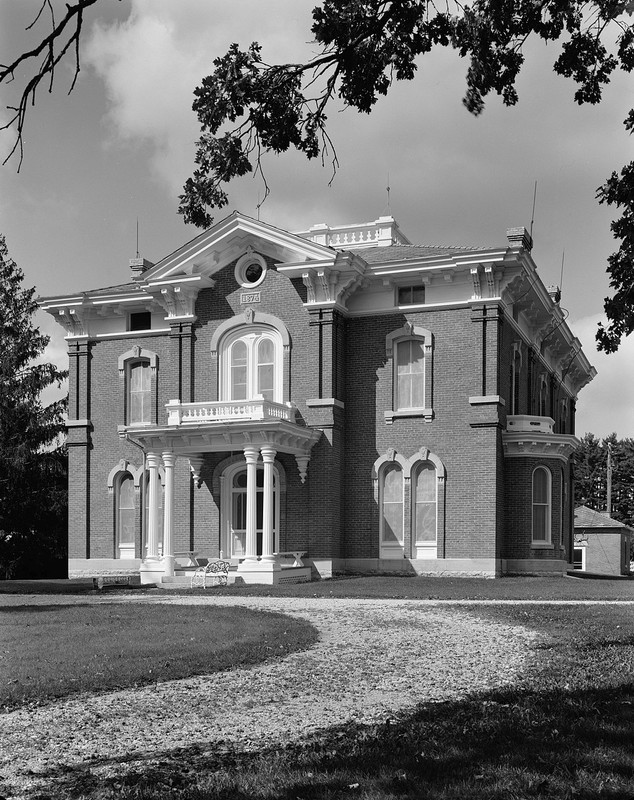Montauk
Introduction
Text-to-speech Audio
Iowa's thirteenth governor, William Larrabee (1832-1912), built this striking Italianate-style home in 1874. Larrabee, who was a Republican, served in the state senate before serving as governor from 1886 to 1890. As governor, he is perhaps best known for reigning in the railroads, which charged high transportation rates and were essentially in control of the state legislature. Visitors to the house will see a variety of furnishings and items on display including Tiffany lamps, Wedgewood china, paintings, marble busts and statues (including statues from Italy), and music boxes from Switzerland. These items reflect the changing tastes and technology of the Larrabee family, who lived in the house until 1967 when they opened it to the public. The house is the centerpiece of a 46-acre property that was once a working farm.
Images
Montauk was built in 1874 by William Larrabee, who served as Iowa's thirteenth governor from 1866 to 1890. The house is open to the public from Memorial Day to the end of October.

Backstory and Context
Text-to-speech Audio
William Larrabee was born on January 20, 1832 in Ledyard, Connecticut. One of nine children, he attended common schools up to eighth grade and for two months enrolled at a private academy. His father also trained him in business. When he was 15 or 16, he lost his right eye in a gun accident. As a young man, he became a teacher and taught briefly in country schools in Connecticut. In 1853, he moved Clayton County, Iowa, where a brother and sister (and her husband) lived.
It appears Larrabee first taught for one term in neighboring Allamakee County and then started working on his brother-in-law's farm as a foreman. Eventually, he started buying land of his own to farm. He worked extremely hard during these years, often 20 hours a day. This effort enabled him to gradually become one of the largest landowners in the state by the 1880s when he owned more than 200,000 acres.
Larrabee's business interests expanded in other ares. In 1857, he settled in Clermont and invested in a flour mill, which he eventually bought out two years later. The mill operated until 1873 when corn became the prevalent crop in Iowa. In 1872, he and brother bought an interest in the First National Bank in McGregor, Iowa. Larrabee would go on to have interests in thirteen banks in Iowa, Minnesota, North Dakota, and one in Clermont by 1885. He also invested in railroads. That experience would help him in his effort to regulate the industry in Iowa as governor.
Larrabee earned a good reputation for being an honest and generous businessman. He supported communities in a variety of ways including providing financial support to schools and churches. His generosity, along with his stature as a leading businessman in Iowa, made him a logical choice for public office and he ran for the senate for the first time in 1867. He was a member of several committees and served as chairman of the Ways and Means committee.
During his years in public office, Larrabee supported a variety of progressive causes including labor rights, women's suffrage, public education, civil rights, racial equality, and, of course, railroad regulation. Oftentimes his Republican colleagues considered his political views too progressive. However, these misgivings did not prevent them from supporting his candidacy to become governor, since their main concern was to weaken the power of the railroads.
Larrabee wanted to serve in the Civil War but his eye injury prevented him from enlisting.
It is relatively modest in appearance compared to others of his stature due to his conservative, New England upbringing.
Sources
Allen, Vice President A.W. "Montauk." National Register of Historic Places Nomination Form. February 21, 1973. https://npgallery.nps.gov/NRHP/GetAsset/NRHP/73000725_text.
"Gov. William Larrabee." National Governors Association. Accessed October 26, 2021. https://www.nga.org/governor/william-larrabee.
"Larrabee, William." The Biographical Dictionary of Iowa. Accessed October 26, 2021. http://uipress.lib.uiowa.edu/bdi/DetailsPage.aspx?id=225.
"Montauk Historic Site History." State Historical Society of Iowa. https://iowaculture.gov/sites/default/files/history-sites-montauk-sitehistory.pdf
Wikimedia Commons
